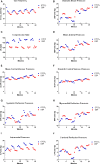Pilot Study to Compare the Use of End-Tidal Carbon Dioxide-Guided and Diastolic Blood Pressure-Guided Chest Compression Delivery in a Swine Model of Neonatal Asphyxial Cardiac Arrest
- PMID: 30371318
- PMCID: PMC6404892
- DOI: 10.1161/JAHA.118.009728
Pilot Study to Compare the Use of End-Tidal Carbon Dioxide-Guided and Diastolic Blood Pressure-Guided Chest Compression Delivery in a Swine Model of Neonatal Asphyxial Cardiac Arrest
Abstract
Background The American Heart Association recommends use of physiologic feedback when available to optimize chest compression delivery. We compared hemodynamic parameters during cardiopulmonary resuscitation in which either end-tidal carbon dioxide ( ETCO 2) or diastolic blood pressure ( DBP ) levels were used to guide chest compression delivery after asphyxial cardiac arrest. Methods and Results One- to 2-week-old swine underwent a 17-minute asphyxial-fibrillatory cardiac arrest followed by alternating 2-minute periods of ETCO 2-guided and DBP -guided chest compressions during 10 minutes of basic life support and 10 minutes of advanced life support. Ten animals underwent resuscitation. We found significant changes to ETCO 2 and DBP levels within 30 s of switching chest compression delivery methods. The overall mean ETCO 2 level was greater during ETCO 2-guided cardiopulmonary resuscitation (26.4±5.6 versus 22.5±5.2 mm Hg; P=0.003), whereas the overall mean DBP was greater during DBP -guided cardiopulmonary resuscitation (13.9±2.3 versus 9.4±2.6 mm Hg; P=0.003). ETCO 2-guided chest compressions resulted in a faster compression rate (149±3 versus 120±5 compressions/min; P=0.0001) and a higher intracranial pressure (21.7±2.3 versus 16.0±1.1 mm Hg; P=0.002). DBP -guided chest compressions were associated with a higher myocardial perfusion pressure (6.0±2.8 versus 2.4±3.2; P=0.02) and cerebral perfusion pressure (9.0±3.0 versus 5.5±4.3; P=0.047). Conclusions Using the ETCO 2 or DBP level to optimize chest compression delivery results in physiologic changes that are method-specific and occur within 30 s. Additional studies are needed to develop protocols for the use of these potentially conflicting physiologic targets to improve outcomes of prolonged cardiopulmonary resuscitation.
Keywords: capnography; cardiopulmonary resuscitation; diastolic blood pressure; pediatrics; physiologic feedback.
Figures


Similar articles
-
End-Tidal CO2-Guided Chest Compression Delivery Improves Survival in a Neonatal Asphyxial Cardiac Arrest Model.Pediatr Crit Care Med. 2017 Nov;18(11):e575-e584. doi: 10.1097/PCC.0000000000001299. Pediatr Crit Care Med. 2017. PMID: 28817508 Free PMC article.
-
The Effect of Asphyxia Arrest Duration on a Pediatric End-Tidal CO2-Guided Chest Compression Delivery Model.Pediatr Crit Care Med. 2019 Jul;20(7):e352-e361. doi: 10.1097/PCC.0000000000001968. Pediatr Crit Care Med. 2019. PMID: 31149967 Free PMC article.
-
End-tidal CO₂ detection of an audible heart rate during neonatal cardiopulmonary resuscitation after asystole in asphyxiated piglets.Pediatr Res. 2011 May;69(5 Pt 1):401-5. doi: 10.1203/PDR.0b013e3182125f7f. Pediatr Res. 2011. PMID: 21283051 Free PMC article.
-
Mechanical versus manual chest compressions for cardiac arrest.Cochrane Database Syst Rev. 2018 Aug 20;8(8):CD007260. doi: 10.1002/14651858.CD007260.pub4. Cochrane Database Syst Rev. 2018. PMID: 30125048 Free PMC article.
-
2017 American Heart Association Focused Update on Pediatric Basic Life Support and Cardiopulmonary Resuscitation Quality: An Update to the American Heart Association Guidelines for Cardiopulmonary Resuscitation and Emergency Cardiovascular Care.Circulation. 2018 Jan 2;137(1):e1-e6. doi: 10.1161/CIR.0000000000000540. Epub 2017 Nov 6. Circulation. 2018. PMID: 29114009 Review.
Cited by
-
Resuscitation practices in hospitals caring for children: Insights from get with the guidelines-resuscitation.Resusc Plus. 2022 Mar 17;9:100199. doi: 10.1016/j.resplu.2021.100199. eCollection 2022 Mar. Resusc Plus. 2022. PMID: 35535342 Free PMC article.
-
Combination of cardiac and thoracic pump theories in rodent cardiopulmonary resuscitation: a new method of three-side chest compression.Intensive Care Med Exp. 2019 Dec 2;7(1):62. doi: 10.1186/s40635-019-0275-9. Intensive Care Med Exp. 2019. PMID: 31792731 Free PMC article.
References
-
- Gupta P, Tang X, Gall CM, Lauer C, Rice TB, Wetzel RC. Epidemiology and outcomes of in‐hospital cardiac arrest in critically ill children across hospitals of varied center volume: a multi‐center analysis. Resuscitation. 2014;85:1473–1479. - PubMed
-
- Tibballs J, Kinney S. A prospective study of outcome of in‐patient paediatric cardiopulmonary arrest. Resuscitation. 2006;71:310–318. - PubMed
-
- Girotra S, Spertus JA, Li Y, Berg RA, Nadkarni VM, Chan PS; American Heart Association Get with the Guidelines Resuscitation Investigators . Survival trends in pediatric in‐hospital cardiac arrests: an analysis from Get With the Guidelines‐Resuscitation. Circ Cardiovasc Qual Outcomes. 2013;6:42–49. - PMC - PubMed
-
- Moler FW, Meert K, Donaldson AE, Nadkarni V, Brilli RJ, Dalton HJ, Clark RS, Shaffner DH, Schleien CL, Statler K, Tieves KS, Hackbarth R, Pretzlaff R, van der Jagt EW, Levy F, Hernan L, Silverstein FS, Dean JM; Pediatric Emergency Care Applied Research Network . In‐hospital versus out‐of‐hospital pediatric cardiac arrest: a multicenter cohort study. Crit Care Med. 2009;37:2259–2267. - PMC - PubMed
-
- Meert KL, Donaldson A, Nadkarni V, Tieves KS, Schleien CL, Brilli RJ, Clark RS, Shaffner DH, Levy F, Statler K, Dalton HJ, van der Jagt EW, Hackbarth R, Pretzlaff R, Hernan L, Dean JM, Moler FW; Pediatric Emergency Care Applied Research Network . Multicenter cohort study of in‐hospital pediatric cardiac arrest. Pediatr Crit Care Med. 2009;10:544–553. - PMC - PubMed
Publication types
MeSH terms
Substances
Grants and funding
LinkOut - more resources
Full Text Sources
Medical

